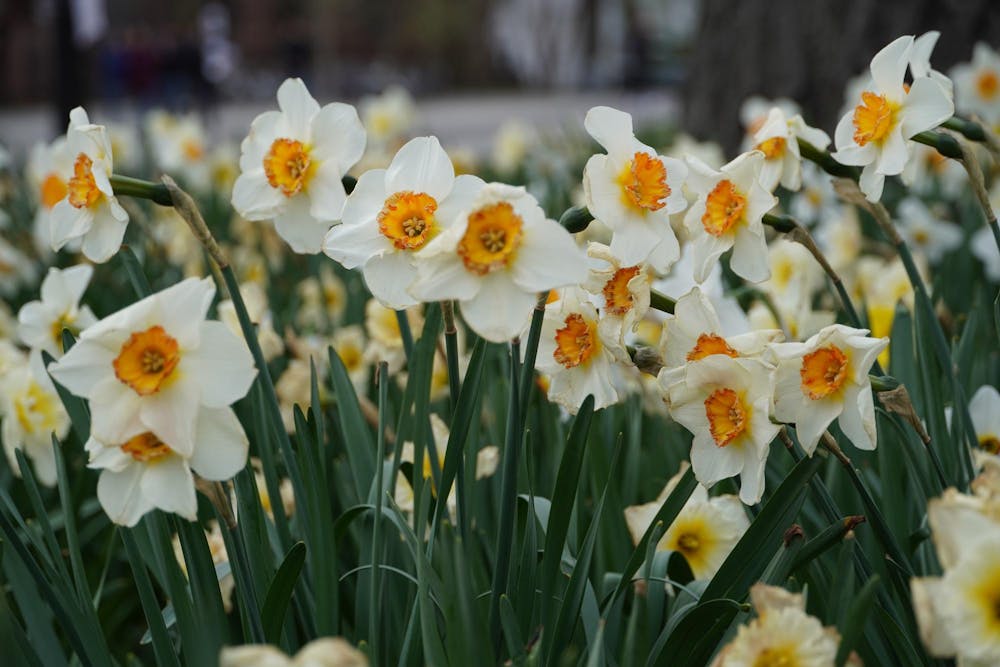As seniors hurriedly finish theses and underclassmen scramble to finalize summer plans, the Campus Grounds Team has been preparing campus for spring and end-of-year events, including alumni and trustee events, Class Day, and Princeton’s biggest bash of the year: Reunions. Approximately 25,000 alumni, parents, students, and friends will visit campus in May. Plantings will continue throughout the month, with sustainable planting strategies being implemented in South campus.
“We distinctly designed this campus for May,” Rob Staudt, the assistant director of Campus Grounds, said in an interview with The Daily Princetonian. His 52-person team is responsible for spring plantings, lawn aeration and maintenance, and general cleaning.
According to Staudt, basic spring clean-up includes raking away old leaves that have fallen throughout the autumn and winter and creating a compost layer. They also clean up the flower beds and let perennials grow before inserting new spring plantings into the beds.
Staudt told the ‘Prince’ that Campus Grounds focuses on “five to seven annuals that [they] know will grow and work out well.” Three flowers in Princeton’s repertoire that students can expect to see are varieties of petunias, begonias, and pansies, tried-and-true plants for Princeton’s campus and this part of the country.
Part of the team’s overall prep is “aeration” which, according to Staudt, breaks up some of the compacted soils after being trampled over and stomped down all winter. Staudt said that Campus Grounds will “try to break up that little bit of ground, and that helps our water infiltrate as well as oxygen. The roots need that oxygen to help the plants grow. We’ll aerate to help strengthen the lawns that we have to get that spring kick from our lawns.”
Students can expect to see Campus Grounds landscaping crews doing work all over campus, but specifically throughout north campus. Staudt said that Campus Grounds “targets larger areas, where [Princeton is] truly going to have events” but that crews will also be working on “overall campus prep.” The crew accomplishes this using tractors pulling spiky aerators across particularly large patches of lawn. Students may have noticed small holes poked into large swaths of grass and lawns appearing bumpier than normal.
The base design for Princeton’s landscaping comes from the landscape architect Beatrix Jones Farrand. Hired by the University in 1912, Farrand inaugurated the campus’ ivy look. Her vision prioritized native plants, seasonal updates, and designs meant to complement the existing natural landscape rather than mask it. In recent years, some community members have called for a return to planting more native species across the Princeton landscape, preserving the horticultural heritage of the region and furthering sustainability across campus.
Farrand’s emphasis on pops of color being isolated to gardens is one element that Campus Grounds has changed from the original landscape architect’s intent. According to Staudt, Princeton’s gardens will get color updates this time of year including the replanting of annual plants. Also, students and faculty, as well as any visitors, can expect to see flowers and their little splashes of color around guard booths at the entrances to campus.

As Princeton starts to develop in new directions, though, so does the Campus Grounds’ strategy. Staudt said that the plantings are changing as you get further south, away from the old campus. Around New College West and Yeh College, Campus Grounds, planting practices are moving towards a “sustainability planting” strategy at the request of the buildings’ architects, according to Staudt.
Staudt told the Prince that this new strategy includes “a lot of natives, more of a meadow type field, perennial garden…that gives a lot more food for birds and butterflies… It helps restore more run-off.”
Nevertheless, whether in new parts of campus or old, Staudt says Campus Grounds works hard “to get the right plant in the right spot.”
Hallie Graham is a News contributor for the ‘Prince.’

Please send any corrections to corrections[at]dailyprincetonian.com.








